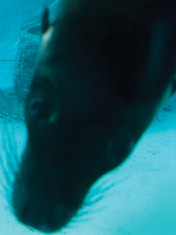
Fishing on the Potomac at Great Falls Park.
Unlike many American cities that architecturally evolve, Washington, DC was, for the most part, created. The lifeblood of DC is its politics, commemorative responsibilities, and international leadership, and as a result of this, aesthetics and the artful appearance of the town have always been a serious consideration in its formation. It is not a city based on industry or manufacturing, but of presentation, and the abundance of gardens, parks, finely landscaped and manicured mansion estates, nature preserves, and window boxes that we will explore in this chapter attests to this. You would be hard pressed to not encounter some flora or fauna in your sight line—Mother Nature and Washington, DC are the best of friends.
By learning to recognize and appreciate beautiful light and trying to capture this quality in your own photographs, you will make enormous strides toward shooting in a similar mode to which professional photographers approach their craft. A pro knows that any scene, recorded at different times of the day, can look vastly different. Very early morning is a lovely time to shoot almost anything. Just before the sun appears, the air has an ethereal glow, whereas the hours immediately following sunrise are radiant with a delicate warmth. The low angle of the sun shortly after it has risen creates long shadows, and these, combined with the possibility of mist, will fill your images with depth and texture. During late afternoon and early evening, depending on the season, you will also see similar qualities. The color of the light toward sunset is even warmer than that of near dawn and is often referred to by pros as sweet light. The light just as the sun sets can be soft and flattering, and with the increased sensitivity of today’s digital chips, you will be able to avoid long exposures. Try to arrange your schedule to shoot at these times, and you will be well rewarded.
If you find yourself out at midday, when the sun is the harshest, with creative thinking there are still ways to bring home professional-quality photographs. Using a polarizing filter will reduce reflections on non-metallic surfaces and will darken the sky. The use of a polarizer is also very effective in reducing reflections off vegetation, which has the effect of saturating leaves and foliage. Shooting in the dappled light from overhead foliage can be a handy way of avoiding noonday sun, and if you take advantage of your fill flash here, you will be especially pleased.
Overcast and even gentle rainy days are perfect for shooting gardens and flowers. The light is diffused and even, keeping shadows to a minimum and saturating the colors. Many photographers, including garden specialists, will hose or mist the surfaces they are shooting to increase color saturation. Leave your hose and mister at home, but do take advantage of a damp and overcast weather forecast by shooting greenery and foliage that day.
The only photo op in this chapter that requires a lens that you may not have in your usual bag of tricks would be the National Zoo. A long telephoto lens is indispensable in shooting portraits of many of the animals. If you do not own one, it is simple to organize the rental of one (and of any other gear you may need) at a camera store such as Penn Camera in the downtown area.
Do remember, however, that the use of a long telephoto may change your normal shooting style. The “shoot from the hip” or quick journalistic approach that you may be familiar with when using a wide to normal lens length is not appropriate when shooting with long lenses. For handheld pictures that have minimal camera shake, be aware of and try to follow the rule of thumb that suggests you set your shutter speed at no slower than the reciprocal of the focal length of the lens. For instance, with your 35mm lens, you may shoot with a shutter speed of 1/35 or faster, whereas with a 300mm lens, you will need to shoot no slower than 1/300 to avoid camera movement.
Working with a tripod and cable release would allow you to skirt around this rule—just be vigilant of where the use of such may be prohibited or inconvenient. I have found that with a very long lens, a little creativity can help you to gain several stops of exposure. Keep your eyes open for places to rest your body and camera while exposing—walls, fences, and gates can all provide firm support. Remember to hold your breath, keep your elbows at your sides, and give yourself stable support by keeping your feet shoulder-width apart. All these techniques will help to keep your images sharp.
Many of the locations in this chapter are secluded enough to allow you to take time and care with your photography. This is a perfect chance for you to play with and really apply some composition and framing techniques that you may have learned. Use this opportunity to hone your skills. Be studious and really look through the lens. Take note of what you are seeing and learn to make photographs rather than simply record a scene.
Experiment with both shallow and deep focus fields and test horizontal and vertical compositions. Do not be afraid to make mistakes, because it is often through these errors that you will serendipitously discover a method that works for you.
The positioning of the nation’s capital along the Potomac River was not an arbitrary choice. Just 10 miles north of Washington, DC stands the Great Falls—a formidable obstacle to river travel and consequently the farthest limit upstream that a major city might be built or advantageously positioned. It’s good news, however, for current residents and visitors to DC, because not far from the city’s refined museums and imposing seats of government stands a quite rugged natural spectacle. Dropping nearly 100 feet in a sequence of 20-foot cascades, the Potomac presents a very different face to its wide and tranquil visage just a few miles downstream. Area residents visit the Great Falls as they tumble through the Mather Gorge and within its environs take advantage of opportunities for hiking, picnicking, kayaking, rock climbing, bicycling, and horseback riding.
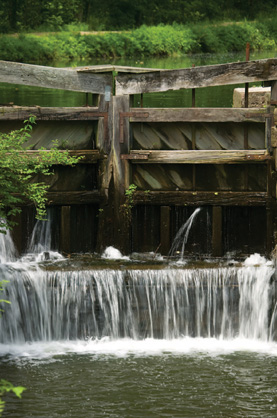
A wooden lock on the towpath.
Access to the falls can be obtained from the Great Falls Park on the west bank or from the Chesapeake and Ohio Canal Park on the east bank. Approaching the Falls from the C&O Canal Park allows you to spend time viewing the historical remains of the canal from the well-maintained canal towpath, which forms the backbone of the park. Built in the 1830s and operated until 1924, the canal provided a solution to the “problem” of the Great Falls and other elevation changes to the north. Running parallel to the Potomac, the canal allowed navigation and a farther 185 miles upstream through a sequence of 74 locks, 150 culverts, 11 aqueducts, and a tunnel of more than 3,000 feet in length.
On your visit to Washington, DC, find your way to the Canal Park, follow the boardwalk to the Great Falls viewing areas, and picture yourself in an altogether different place.
Note
Waterfalls will look silken and smooth if you shoot the rushing movement with a slow shutter speed. A setting of 1/20 (employed in the image of the wooden lock) or 1/10 of a second will give you a nice flowing wall of water, which will add to the peaceful feel of a scene.
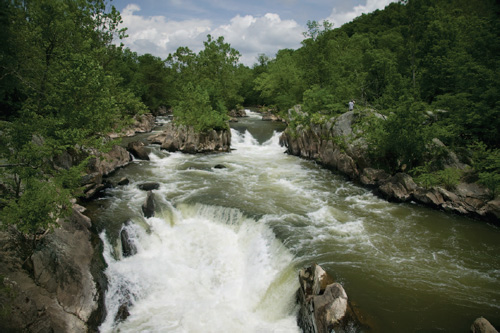
The rapids at Great Falls.
As I was peering through the viewfinder while taking this photograph, I felt immediately transported to the coast of South Africa or as if I was witnessing a Japanese watercolor come to life. The majesty of this bird, a Great Blue Heron, took my breath away, with his seven-foot wingspan and supremely graceful flight. Patience and good timing allowed me to capture this image—I must have had my lens trained on him for 25 minutes while he canvassed the rapids for his fishy dinner. I assumed that he would eventually, whether successful in his quest or not, fly away, and I had my finger at the ready on the shutter release button. My short shutter speed caught both his rapid movement and that of the water as it roiled underneath him.

Focal length 300mm; ISO 100; aperture f/5.6; shutter speed 1/1600; May 12:36 p.m.
A walk along the C&O Canal towpath will proffer many serene and bucolic scenes that are in stark contrast to the rapid waters of the Great Falls themselves. The shoreline and trees are mirrored in the brackish water, and strong, painterly compositions can be found at many points on the path. I liked the way the trees here had a kind of dynamism—they almost looked as if they were growing rapidly before my eyes, and the intensity of their green foliage was striking. The concrete structure in the water balances the strip of sky above, and the gray of the tree bark adds strong diagonal lines.
The C&O Canal Park can be most readily reached by car. Leave Georgetown traveling west on Canal Road. Follow Canal Road as it turns northwest, parallel to the old canal route. After three miles, at the Chain Bridge, the road name changes to Clara Barton Parkway and continues for a further six miles, passing Route 495 (the Capital Beltway at Junction 41), until it reaches a T junction at MacArthur Boulevard. Turn left and continue for one additional mile and look for parking spaces on the street and access trails down to the canal. From here, you can walk along either of the canal banks to reach the boardwalk to the viewing platforms. Continuing by car two miles farther along MacArthur Boulevard will bring you to the park Visitor Center, which allows for the closest approach by car to the Falls.
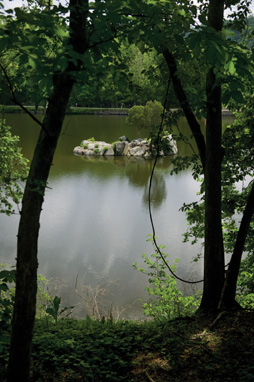
A view of the canal from the wooded side.
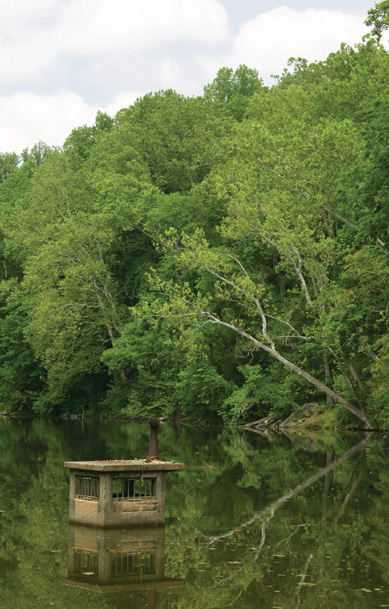
Focal length 90mm; ISO 100; aperture f/8; shutter speed 1/50; May 11:29 a.m.
In 1955, Marjorie Merriweather Post, heiress to the Post cereal empire, purchased the Arbremont Estate located in northwest Washington, adjacent to the southern end of Rock Creek Park and north of the National Zoo in Woodley Park. Ms. Post transformed the estate inside and out. The mansion was internally remodeled to allow for the display of an extensive collection of 18th- and 19th-century French art and a large collection of Russian Imperial art acquired when the owner’s husband served as the American ambassador to Russia. Today, these collections form the centerpieces of a formal museum.
The gardens underwent a spectacular metamorphosis. Twelve of the twenty-five acres were converted to formal gardens, each featuring a separate theme—French, Japanese, Rose, and for formal outdoor receptions, the Lunar Lawn. An extensive greenhouse was built to support the gardens and to house a glorious collection of 2,500 orchids, while a separate Cutting Garden was established as a source of cut flowers to enhance the museum. The estate is now supported and managed by the Post Foundation and is open to the public from Tuesday through Sunday throughout most of the year. The gardens are at their most spectacular in the spring and fall.
Marjorie Merriweather Post passed away in 1973. Visit Hillwood and savor the legacy of intense beauty and elegance that she left behind.
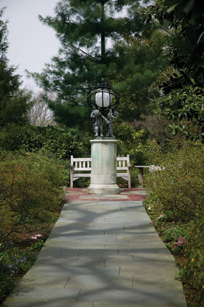
One of the outdoor gardens.
This is a view of the western flank of the Hillwood House from the Rose Garden, which was designed by Perry Wheeler, a landscape architect who had also worked on the same at the White House. Mr. Wheeler was widely known for his cutting-edge use of pavers, creating intricate patterns in paths, and for using a grand variety of materials. His playful array of organic elements is what gives this photograph such interest and keeps the viewer’s eye moving back and forth to absorb it all. There is a plethora of objects in this composition, yet they are so artfully arranged that the final design is complex and still beautiful. The delicate play of light and shadow on every surface and the spots of complementary colors only add to the visual appeal.
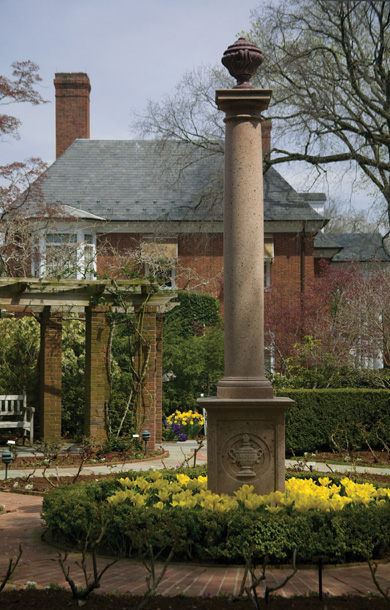
Focal length 70mm; ISO 100; aperture f/5.6; shutter speed 1/160; April 1:14 p.m.
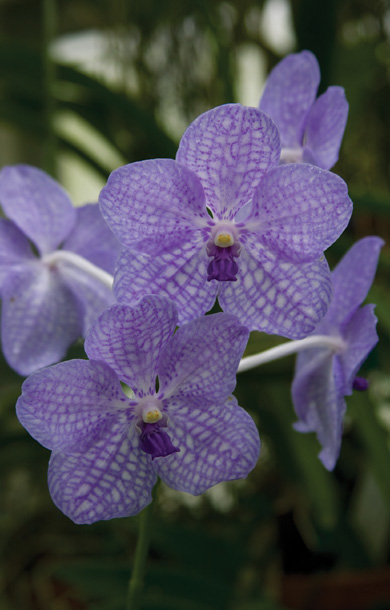
Focal length 90mm; ISO 100; aperture f/7.1; shutter speed 1/80; April 11:56 a.m.
Blue orchids are uncommon, and this one, with its unusual checkered petals, made quite a statement in the Hillwood greenhouse. The color is an odd one to encounter in nature, and bathed by diffused light, the flowers seemed to emanate an unearthly glow, especially in contrast to the deep green of the leaves. Zoom in close to the flowers to show the texture and design. When shooting at such proximity to a subject like flowers, which have depth, a midpoint aperture such as f/7.1 is necessary to keep the facing petals in focus but still allow the background to go soft. This relieves distraction and keeps viewers’ eyes on the flowers. The condensation that lines the greenhouse glass keeps the light level inside quite low, so be sure to have your tripod on hand.
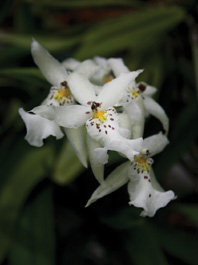
Another beautiful specimen.

A tangle of hanging plants in the greenhouse.
Hillwood Estate, Museum, & Gardens is located at 4155 Linnean Avenue NW. It is one of the few destinations in Washington where travel by car is recommended. The estate provides complimentary parking and easy access. Proceed north on Connecticut Avenue from downtown DC. Go through Woodley Park and past the National Zoo and then turn right onto Tilden Street. Take the second left onto Linnean Street. The estate will be on your right.
The estate is closest to the Van Ness Metro station (Red Line). From the station, walk south on Connecticut Avenue and turn left onto Upton Street. Turn right onto Linnean Avenue. The entrance to the estate will be on your left.
Through its 120 years of existence, the National Zoo has presented to visitors a fascinating array of fauna. The zoo has stood as a characterizing element of Washington, clearly living up to its status as the National Zoo.
The zoo was established in 1889 by an Act of Congress, and the park was designed and built at its current location in Woodley Park. Through its first 60 years, coinciding with the era of the big game hunter, the role of the zoo was very much as a presenter of exotic and spectacular wildlife.
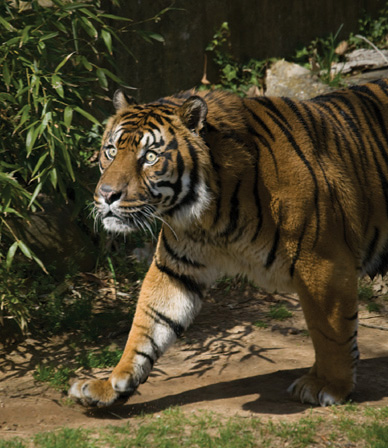
A tiger on a prowl.
In the 1950s, the Smithsonian Institution took on sole responsibility for the zoo. In the ’60s, the zoo’s personnel refocused on the study of animal breeding and the protection of threatened species.
The zoo has been famous for its efforts to secure the future of the Giant Panda. Much research effort and support has been given to Ling Ling and Hsing Hsing (and more lately, Mei Xiang and Tian Tian) in their efforts to become panda parents. Development of the zoo has continued with installation of the Kid’s Farm in 2004 and more recently the Asia Trail, providing a habitat for seven rare Asian species, including the sloth bear, red pandas, and cloud leopards. Elephant Trails—a major new program—includes extended facilities at the zoo and expanded research programs aiming to aid endangered elephant populations around the world. The zoo presently stands tall among the ranks of those committed to the protection of the Earth’s threatened biodiversity.
Some people will do almost anything not to have their photograph taken, and the same goes for some members of the animal kingdom. This giant anteater, for instance—she is so shy that in the wild, when her habitat is near humans, her behavior will change from diurnal to nocturnal in order to avoid human contact. And, take note of her camouflage— which appendage is her head and which is her leg? She would much rather quell attention than attract. Needless to say, in order to get this picture, I had to arrive at her pen right at mealtime, when she and her baby (see the little one riding piggy-back?) paced the enclosure in anticipation of their insect-laden dinner. Photographing animals is all about patience and good timing. You must wait and wait with your camera at the ready for that photogenic instant, and when it happens, be fast! Anticipate the moment and take several frames to cover yourself. You probably will not get a second chance.
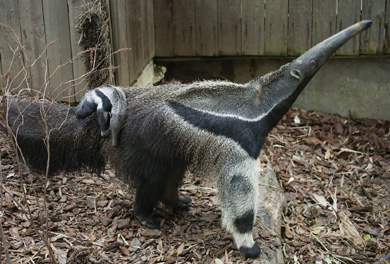
Focal length 70mm; ISO 100; aperture f/5.0; shutter speed 1/50; April 2:48 p.m.
This gray seal, on the other hand, was as outgoing as a high school cheerleader. He and his mates played games and performed at a ferocious pace for the onlookers. The vantage point for spectators is very close to the enclosure, and since the seals move so quickly and unpredictably, it is somewhat difficult to capture them in “flight,” even with a wide-angle lens. Again, as with most of the zoo animals, feeding time became a perfect opportunity for a portrait. This shot was taken from the walkway at the perimeter of their pool, and the seal was so focused on the trapdoor through which would come his dinner that I was able to capture several good frames. A long telephoto lens enabled me to capture an intimate and anthropomorphic portrayal of this seal, with all his facial and dermatological aspects in great detail.

A red-ruffed lemur.
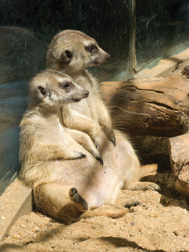
Meerkats, looking as if they’re relaxing after a beer and a pizza.
The National Zoo is located at 3001 Connecticut Avenue NW in Woodley Park. The zoo can be reached on the Metro Red Line, either from the Woodley Park/Zoo/Adams Morgan stop or from the Cleveland Park stop. The zoo lies halfway between these stops, and both are a half-mile or less from the zoo. From Woodley Park-Zoo station, walk north (gently uphill) on Connecticut Avenue. The zoo entrance will be on your right. From the Cleveland Park stop, walk south on Connecticut and look for the zoo on your left.
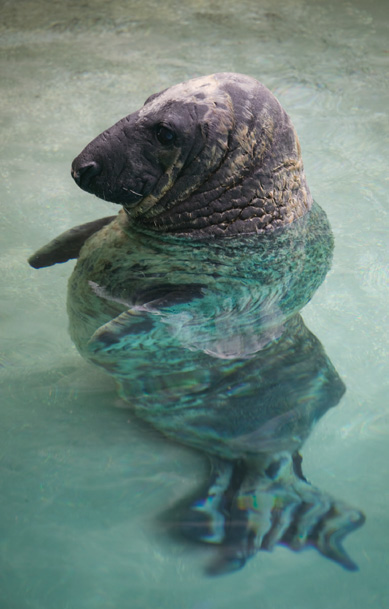
Focal length 250mm; ISO 100; aperture f/5.6; shutter speed 1/40; April 3:02 p.m.
Reflecting the importance of the nineteenth-century fishing industry in the northeast, a National Aquarium was established in Wood’s Hole on the coast of Massachusetts in 1873. Five years later, the aquarium came to DC, when it was moved to Babcock Lakes, a set of holding ponds located near the current site of the Washington Monument. This was followed in the 1880s by another move to holding pens and a small aquarium located at the current site of the Air and Space Museum on the south side of the Mall. When the Department of Commerce building was constructed in 1932, the aquarium was located in the lower level and has remained there ever since. Federal funding for the aquarium was withdrawn in 1982, but since then, the institution has been governed by the National Aquarium Society, a private nonprofit organization. In 2003, the Washington Aquarium entered into an alliance with the National Aquarium in Baltimore, allowing the aquariums to collaborate in the development of their collections and educational outreach.
The National Aquarium in Washington welcomes 200,000 visitors a year to view 1,500 specimens representing more than 250 species. Special exhibits feature environmentally sensitive aquatic environments. Through its displays and programs, the aquarium fulfills its chosen mission of seeking to inspire enjoyment, respect, and protection of the aquatic world.
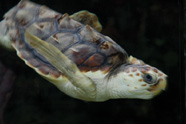
A baby loggerhead turtle.
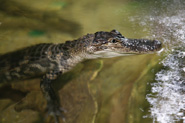
Keeping a watchful eye.
Making photographs at the National Aquarium is a little like taking a vacation from your vacation. It is a surreal experience to wander in this subterranean fishbowl during the day, which is what happened to me when I had a yen to be creative but needed to escape the harsh light of noon in order to do so. Shooting the sea creatures below is all about having fun, playing with colors, and making art out of the crazy shapes and textures that surround you. This anemone, a Heteractis crispa, is in a tank on the left side of the entrance to the aquarium and is very well lit compared to many of the other exhibits. I did not use a tripod for this shot, but I did set my ISO to 200 to glean an extra stop and leaned my camera against the thick glass of the tank for support. Crop in very closely, which, in addition to highlighting the incredible color of the tips and translucent texture of the “arms,” turns the photo into an abstract expression, rather than a simple document, which is what you would get if you included the anemone’s environs in the crop.
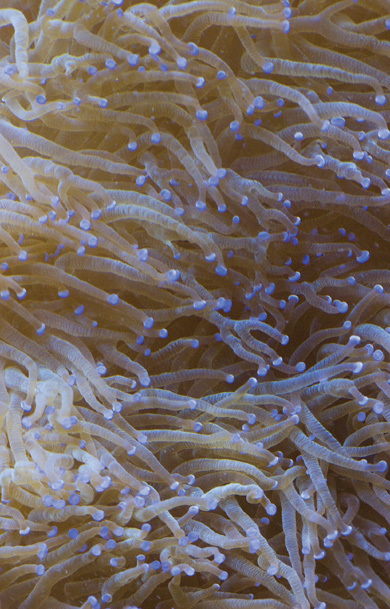
Focal length 95mm; ISO 200; aperture f/4.5; shutter speed 1/100; April 12:23 p.m.
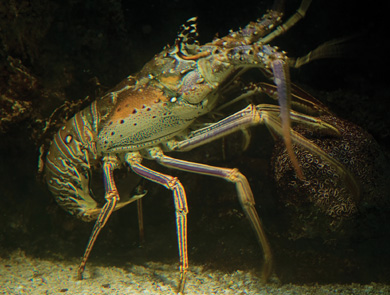
A lobster.
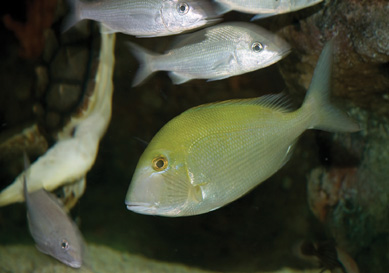
Friends of the loggerhead.
I could not even truly believe that these things (sea anemones called Tealia lofotensis) were real when I rounded the corner and came across their tank. The colors and textures astounded me, and I must have shot at least 20 frames—I was so excited by their appearance! This tank was very dim, and I had to use my tripod to avoid any camera shake. To keep from bothering other visitors when in a public place such as this, I often do not spread the legs of my tripod but keep them tightly pressed together and use it more as a monopod. This gives me a great deal of steady support while still maintaining a relatively low profile. I also used my on-camera flash, but set at two stops under to keep its effect very, very subtle. If you do use your flash, to avoid any reflection from the glass, you must be very careful to always shoot at an angle of close to 45 degrees to front of the tank. Any more direct than that, and you will catch the reflection of the flash in the glass.
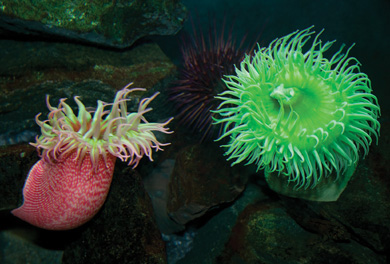
Focal length 95mm; ISO 100; aperture f/5.6; shutter speed 1/5; April 3:04 p.m.
From the Federal Triangle Metro station (Orange and Blue Lines), walk south on 12th Street for a few yards and then turn right along Constitution Avenue. After one block turn right on 14th Street; the rather austere façade of the Department of Commerce will be on your left. The Aquarium is located in the lower level of the building. Be sure to ask at the front desk whether tripod use is allowed that day—they are flexible.
The early development of the American colonies owes much to the development of trade opportunities, equally as important to the colonists as their desire for political or religious freedom. The area at the navigable limit of the Potomac proved to be an attractive site for the development of commercial communities providing markets and trading centers for the interior regions of the new country. Georgetown, on the eastern banks of the Potomac, is one example, while the town of Alexandria, located across the Potomac, is another. The first colony on the current site was established in 1695, while the street plan that has survived to the present day was originally laid out in 1749. Alexandria remained an important port throughout the colonial, revolutionary, and Civil War periods.
Much of the sense of the original Alexandria persists within Old Town. This portion of Alexandria includes the original town and its grid plan and runs down to the waterfront. The area features a blend of historic buildings and museums with a revitalized community of modern shops, hotels, and restaurants.
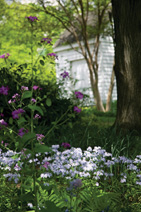
A small park behind the Carlyle House.
This is the type of photograph that is served up to you—as a result of classic architecture, good landscaping, and beautiful weather, this shot existed right before my eyes. My responsibility was to notice it, compose, and crop. An impression of “collage” occurs as a result of all the intersecting planes, lines, and textures, and the use of the telephoto lens, as short as it was, has flattened the photograph and given it a very graphic quality. A wide aperture gave me a very shallow depth of field, with only the leaves and finial at midground in perfect focus. The polarizing filter converted the harsh light of midday to a lush and color-saturated view. This backyard scene is on Fairfax Street, very close to the intersection of Duke Street, and is readily visible from the sidewalk. Remember to keep your eyes open all the time, and you will discover photo ops in many surprising locales.
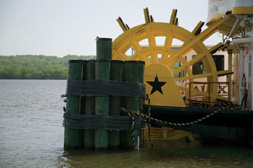
A paddlewheel boat on the Potomac.
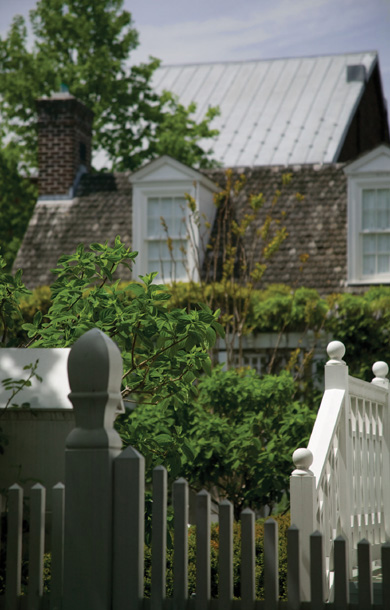
Focal length 115mm; ISO 100; aperture f/5.6; shutter speed 1/400; April 11:57 a.m.
At the intersection of Duke Street and the Strand, you will find before you a busy pier with restaurants, docked boats, and a waterfront park with a row of benches facing the Potomac River. The figure of this woman added a soft and organic element to an otherwise extremely hard and linear arrangement. I composed this photograph very purposefully and was conscious of placing all the elements exactly where I intended for them to be. The top of the bench in the foreground made a solid base for the picture, and I placed the woman close to the center of the frame. The two bright blue shapes add a touch of visual tension, as does the very small strip of water that is visible above the two upright posts. Details such as these are extremely important and can separate a mediocre picture from a very good one. This photograph contains a peaceful scene, but the eye is kept moving over the frame as the viewer’s gaze follows the lines and shadows.
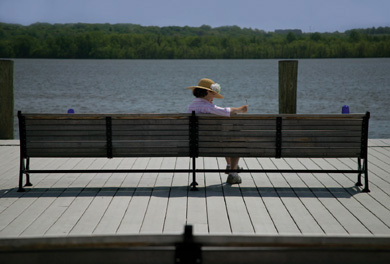
Focal length 109mm; ISO 100; aperture f/5.6; shutter speed 1/1000; April 10:21 a.m.
The Yellow or Blue Metro Line will take you from DC into Virginia and south along the Potomac to King Street Station in Alexandria. The station is located to the west end of Old Town. Walking east on King Street will take you through the town, reaching the waterfront after about one mile. To avoid the walk, take the Red or Yellow Dash bus line that runs from the Metro station along King Street to the waterfront.
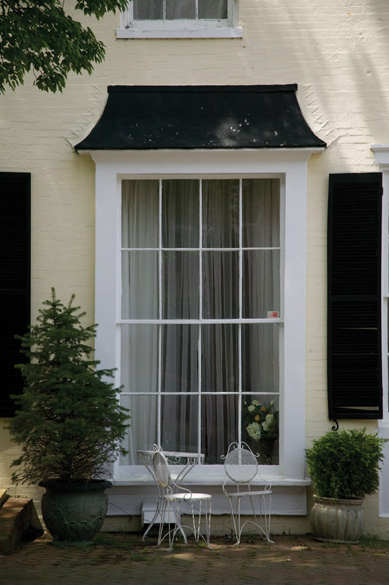
Classic Old Town Alexandria.
Rock Creek, never more than a moderately sized stream, wends its way out of Maryland and cuts through northwest DC, finally joining with the Potomac just to the south of Georgetown and Foggy Bottom. The creek, however, forms the backbone of Rock Creek Park, a major feature of Washington, DC. At its southern end, below the National Zoo, the park is a fairly narrow band of land enclosing the Rock Creek and Potomac Parkway. On the other hand, the northern portion comprises one of America’s oldest national parks, having been formally instituted in 1890. But, as a visitor, you might be excused for not initially recognizing its presence. Although Rock Creek Park, at 1,754 acres, is more than twice the size of Central Park in New York City, it is easy to travel around DC and not encounter its green attractions.
The park passes through a valley in the topography of the city, and many of the thoroughfares in its vicinity, particularly those nearer to the city center, pass over on bridges rather than directly through the park. However, finding your way down into the park is well worth the effort, as you will find a hiking, biking, jogging, and picnicking refuge close to the heart of the city.
The park is under the jurisdiction of the National Park Service, which oversees a wealth of recreational facilities and cultural exhibits, such as the Nature Center and Planetarium, the venerable Pierce Mill, and multiple relics of Civil War fortifications.
It is more likely that a photograph such as this would be taken in the rural outskirts of a town, but no…I am standing literally smack dab in the center of vibrant and populated Washington, DC. This view is from the Duke Ellington Bridge that reaches over Rock Creek Park and carries Calvert Street from Woodley Park into Adams Morgan. The overpass that is captured in the photograph is the Connecticut Avenue Bridge. What grabbed my eye first was the verdant foliage and its incredible variety of tones, shapes, and textures—the bridge seemed to be bobbing along on a rolling sea of green leaves. This ocean of color constitutes a majority of my frame, as that is what I really wanted the viewer to focus on. The shape of the bridge is a solid and grounding element topped by a crisp, blue sky, whose primary hue is a perfect complement to the vibrant greens of the foreground.
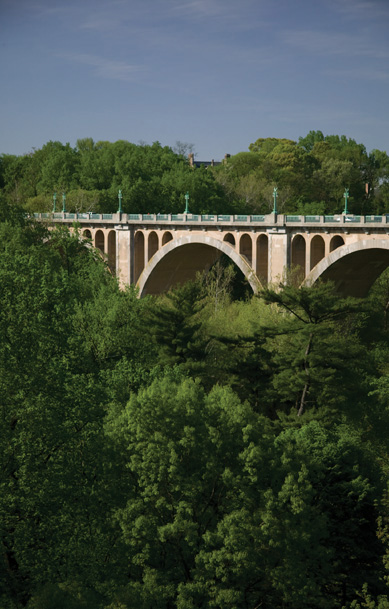
Focal length 85mm; ISO 100; aperture f/5.6; shutter speed 1/200; April 8:10 a.m.
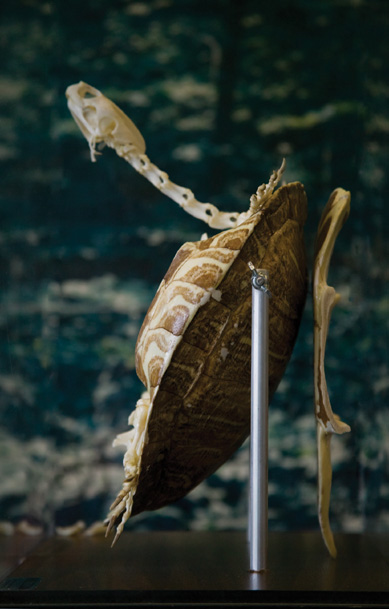
Focal length 135mm; ISO 400; aperture f/5.6; shutter speed 1/50; April 10:21 a.m.
The Information Center at the northern end of the park boasts an interesting and quirky display of preserved indigenous flora and fauna. There is a plentiful selection of table-sized dioramas, all of which have slightly yellowed photographs as their backgrounds, lending a certain nostalgic feel to the ambience. This, in conjunction with the rust-colored carpet and bas-relief black-and-white plastic information labels, brought me back to elementary school science class days!
Making photographs of the displays is a nod to those artists who have photographed the larger, more complex, and much better known dioramas at the Museum of Natural History in NYC. It is half art and half documentary museum photography—your background is an existing photograph, and you are capturing someone’s ready-made arrangement. The visual irony is that the scene is meant to be experienced live, not secondhand. The room is dim, so be sure to either bring your tripod or gain some f-stops by increasing your ISO.
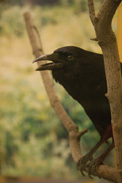
A feathered friend in a diorama.
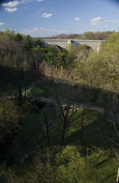
The shadow of the Connecticut Avenue Bridge.
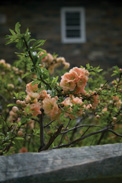
Quince blossoms at the Pierce Mill.
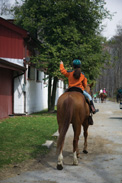
Riding is one of many activities in Rock Creek.
Unless you are an intrepid bike rider, Rock Creek Park is actually best visited by car. Beach Drive passes around the zoo and then through the remainder of the park to the north. It can be accessed from Connecticut Avenue just to the south of the Woodley Park Metro station by taking 24th Street down to the park level. The Rock Creek Nature Center and Planetarium is located at 5200 Glover Road NW, near the intersection of Military Road and Glover Road. Military Road intersects Beach Drive near the center of the park. When travelling north on Beach Drive, turn left on Military Road and look out for the signs indicating Glover Road and the Nature Center on your left.
The unusual proximity of the U.S. Botanic Garden to the seat of government can be traced back to its inception at an early date in the life of the capital of the new republic. In 1816, the Columbian Institute for the Promotion of Arts and Sciences promoted the inception of a botanic garden as a repository for plants that might be distributed throughout the country to the benefit of U.S. citizens. The garden was established at the eastern end of the Mall in front of the western face of the Capitol, but it fell into decline with the demise of its parent organization in 1837. In 1842, the Wilkes Exploring Expedition returned from the South Seas, and their collected bounty drove the need for and the rebirth of the Botanic Garden. The garden was fully stocked and reestablished by 1850 and has remained continuously in operation ever since. However, to realize the original design of the Mall as an open space at the center of the city, the garden was moved in the early 1930s to its current position, still adjacent but now directionally to the southwest of the Capitol.

A beautiful sample from the Rose Garden.
Today’s garden consists of three parts: the Conservatory, the National Garden, and Bartholdi Park. The recently renovated Conservatory houses more than 4,000 plants from widely varying climes and features exhibits and educational programs throughout the year. The National Garden is a 2006 addition to the complex. It serves as an outdoor learning center and features the First Ladies’ Water Garden and rose and butterfly gardens against a background of local plants from the mid-Atlantic region. Opposite the Conservatory, Bartholdi Park majors in decorative landscaping organized around a classical fountain whose designer, Frédéric Auguste Bartholdi, also created the Statue of Liberty. It is unlikely that any other world capital features such botanical diversity so close to its center.
If you are a fan of Edward Weston’s black-and-white photography, you will recognize immediately here my homage to his inimitable work. This plant is a Parry’s Agave and can be found in the Succulent section of the Botanic Garden. The lighting in the plant conservatories is beautiful—a huge expanse of frosted-glass ceiling makes it seem as if you are in your own personal north-light painter’s studio. The light can get dim here during an overcast day, and your exposures may get too long for shooting handheld, so be sure to bring your tripod with you. Once I found this plant, I worked with it for a good length of time to find the most comfortable composition—it looked best off center both left to right and top to bottom.
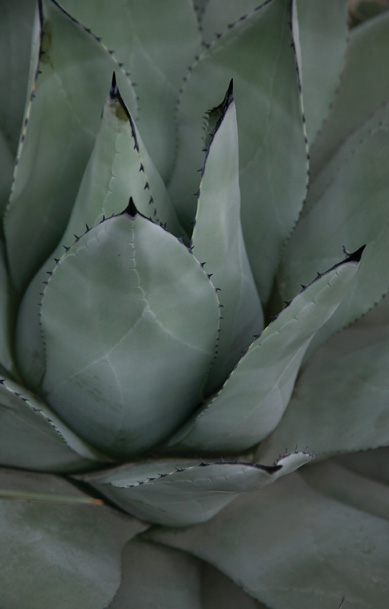
Focal length 135mm; ISO 100; aperture f/7.1; shutter speed 1/50; April 11:44 a.m.
In some respects, the formal layout of many parts of the garden leaves your photographic compositions to the ready and waiting. All that is left is for you to find the best vantage point. This pool can be found in the very front of the conservatory and is surrounded by colorful plantings throughout the year. Park yourself at the easternmost end of the pool and face into the center of the central lobby. Again, your tripod will be handy if it is a dark day. Frame your photograph so that the fountains are central, and focus on the far end of the pool. The plants in the foreground that frame your edge will become nicely soft-focus. You will need infinite patience to wait for your photograph to be free of passersby—the garden is a popular place.
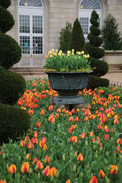
The entrance to the gardens in spring.
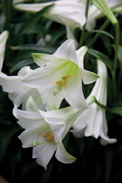
Easter lilies.
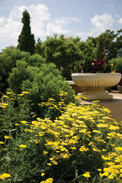
A display at Bartholdi Park.
To find the Botanic Garden complex, aim for the intersection of 1st Street SW and Independence Avenue to the southwest of the Capitol building. The closest subway approach is Federal Center SW on the Orange and Blue Lines. From the station, walk north on 3rd Street for two blocks and turn right on Independence Avenue. This will take you past the National Garden on your left and then position you between Bartholdi Park and the Conservatory. In general, if you are strolling through the area, the parks are accessible through gates on several sides.
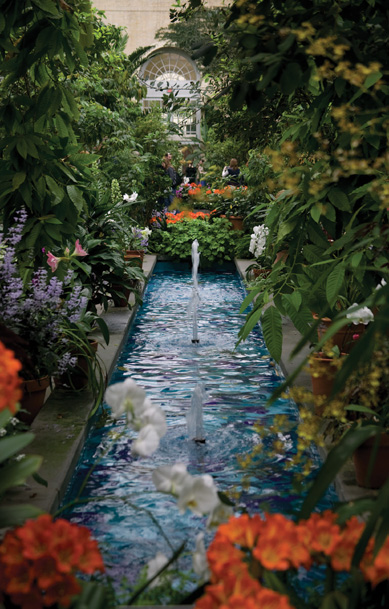
Focal length 70mm; ISO 100; aperture f/5.6; shutter speed 1/25; April 12:01 p.m.
Washington, DC is a great capital, with a dramatic layout and majestic federal buildings. The downtown area, with its wide streets and avenues, is the equal of other major American cities, while the northwest suburban areas and boulevards speak of refined opulence. Yet the residents of DC do not rest on their laurels. Throughout the District, the horticultural arts are on fine display with embellishment of buildings large and small. Of unusual charm are the row houses dating from the earliest decades of the capital’s development, often situated close to the center of the city but presenting a cottage-like appeal set off by old-world-style gardens. Be aware of opportunities to capture evidence of Washingtonians’ green thumbs at every turn.
The weather outside was overcast and gently misting, so rather than curl up with a good book, I quickly (in case of a downpour) packed up my gear and headed out to find some flowers. There are some moments when all the elements for perfect picture-taking fall seamlessly into place, and this was one of those times. The thinly clouded sky cast a beautiful diffused light over all beneath it, and the pinks and magentas of these Knock Out roses looked so intense in contrast to the dark green foliage behind them. But, the meteorological element I was most grateful for was the blanket of rain droplets that clung to every surface like miniature magnifying lenses. The drops contribute so much crystalline texture, lushness, and verdancy to the photograph.

Focal length 75mm; ISO 200; aperture f/7.1; shutter speed 1/10; May 6:04 p.m.
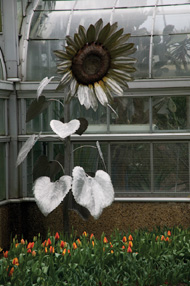
A very urban garden—sunflower in metal.

A patriotic garden near the Capitol building.
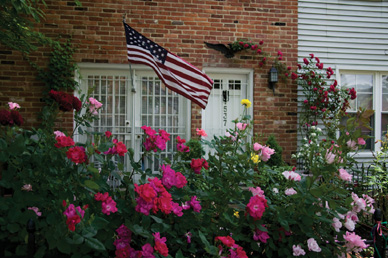
A vignette in Adams Morgan.
It is difficult not to love shooting flowers—they are just so beautiful! Many of the homes immediately behind the Capitol building sport small but fertile lots, and in spring and early summer, there is a riot of color and variety. This white peony bush stood out as a real specimen. The flowers are backlit, which perfectly highlights the layout of the petals, their serrated edges, and the complex yellow stamens. This is an “environmental portrait,” if you will, as opposed to the earlier beauty shot of the roses, and the composition is dynamic with the foliage forming a grounded triangle in the foreground. Because of my use of a wide aperture, the background is soft, and its shadowed areas frame the flowers and are not distracting. There is enough detail available to give some information about the locale—the wrought-iron fence, the vintage architecture, and the American flag all give a hint to the garden’s personality.
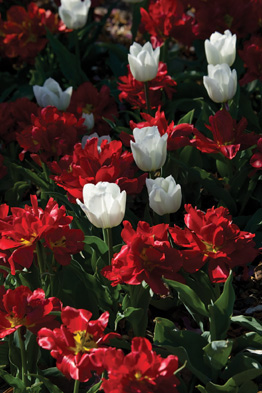
Red and white tulips.
Row houses and their charming gardens can be found in many parts of DC, but look for some excellent gardens to the north of M Street in Georgetown or on Capitol Street SE to the south of the Capitol building. Further out into the northwest suburbs beyond Woodley Park, you will find a multitude of choice gardens.
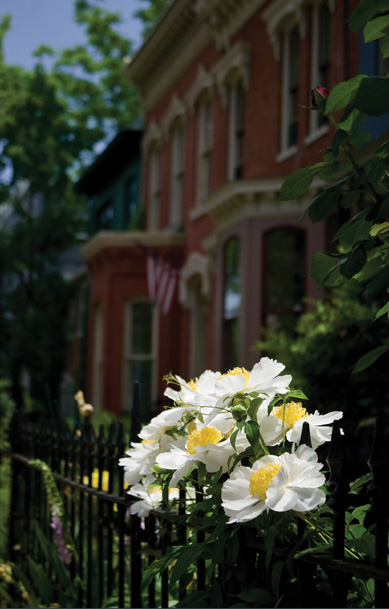
Focal length 70mm; ISO 100; aperture f/5.0; shutter speed 1/320; May 11:59 a.m.

